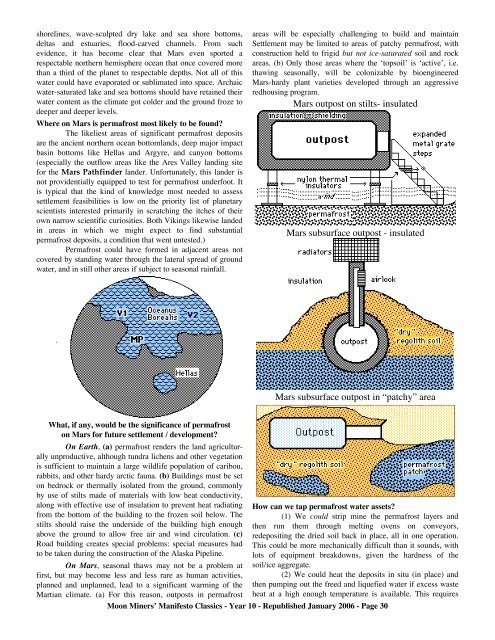MMM Classics Year 10: MMM #s 91-100 - Moon Society
MMM Classics Year 10: MMM #s 91-100 - Moon Society
MMM Classics Year 10: MMM #s 91-100 - Moon Society
You also want an ePaper? Increase the reach of your titles
YUMPU automatically turns print PDFs into web optimized ePapers that Google loves.
shorelines, wave-sculpted dry lake and sea shore bottoms,<br />
deltas and estuaries, flood-carved channels. From such<br />
evidence, it has become clear that Mars even sported a<br />
respectable northern hemisphere ocean that once covered more<br />
than a third of the planet to respectable depths. Not all of this<br />
water could have evaporated or sublimated into space. Archaic<br />
water-saturated lake and sea bottoms should have retained their<br />
water content as the climate got colder and the ground froze to<br />
deeper and deeper levels.<br />
Where on Mars is permafrost most likely to be found?<br />
The likeliest areas of significant permafrost deposits<br />
are the ancient northern ocean bottomlands, deep major impact<br />
basin bottoms like Hellas and Argyre, and canyon bottoms<br />
(especially the outflow areas like the Ares Valley landing site<br />
for the Mars Pathfinder lander. Unfortunately, this lander is<br />
not providentially equipped to test for permafrost underfoot. It<br />
is typical that the kind of knowledge most needed to assess<br />
settlement feasibilities is low on the priority list of planetary<br />
scientists interested primarily in scratching the itches of their<br />
own narrow scientific curiosities. Both Vikings likewise landed<br />
in areas in which we might expect to find substantial<br />
permafrost deposits, a condition that went untested.)<br />
Permafrost could have formed in adjacent areas not<br />
covered by standing water through the lateral spread of ground<br />
water, and in still other areas if subject to seasonal rainfall.<br />
What, if any, would be the significance of permafrost<br />
on Mars for future settlement / development?<br />
On Earth, (a) permafrost renders the land agriculturally<br />
unproductive, although tundra lichens and other vegetation<br />
is sufficient to maintain a large wildlife population of caribou,<br />
rabbits, and other hardy arctic fauna. (b) Buildings must be set<br />
on bedrock or thermally isolated from the ground, commonly<br />
by use of stilts made of materials with low heat conductivity,<br />
along with effective use of insulation to prevent heat radiating<br />
from the bottom of the building to the frozen soil below. The<br />
stilts should raise the underside of the building high enough<br />
above the ground to allow free air and wind circulation. (c)<br />
Road building creates special problems: special measures had<br />
to be taken during the construction of the Alaska Pipeline.<br />
On Mars, seasonal thaws may not be a problem at<br />
first, but may become less and less rare as human activities,<br />
planned and unplanned, lead to a significant warming of the<br />
Martian climate. (a) For this reason, outposts in permafrost<br />
areas will be especially challenging to build and maintain<br />
Settlement may be limited to areas of patchy permafrost, with<br />
construction held to frigid but not ice-saturated soil and rock<br />
areas. (b) Only those areas where the ‘topsoil’ is ‘active’, i.e.<br />
thawing seasonally, will be colonizable by bioengineered<br />
Mars-hardy plant varieties developed through an aggressive<br />
redhousing program.<br />
Mars outpost on stilts- insulated<br />
Mars subsurface outpost - insulated<br />
Mars subsurface outpost in “patchy” area<br />
How can we tap permafrost water assets?<br />
(1) We could strip mine the permafrost layers and<br />
then run them through melting ovens on conveyors,<br />
redepositing the dried soil back in place, all in one operation.<br />
This could be more mechanically difficult than it sounds, with<br />
lots of equipment breakdowns, given the hardness of the<br />
soil/ice aggregate.<br />
(2) We could heat the deposits in situ (in place) and<br />
then pumping out the freed and liquefied water if excess waste<br />
heat at a high enough temperature is available. This requires<br />
<strong>Moon</strong> Miners’ Manifesto <strong>Classics</strong> - <strong>Year</strong> <strong>10</strong> - Republished January 2006 - Page 30















